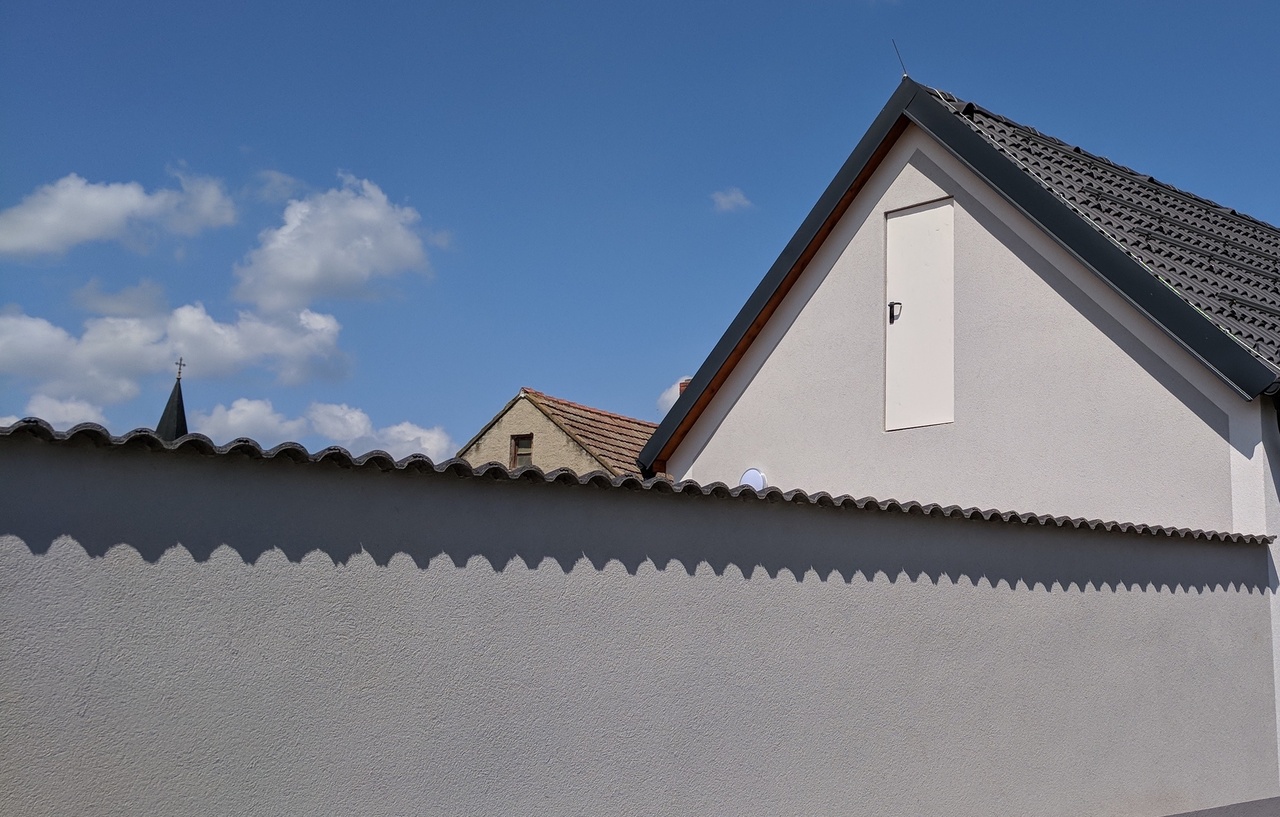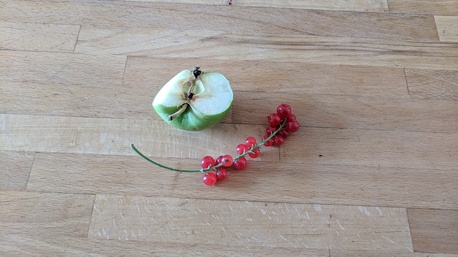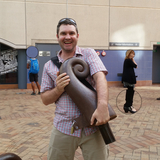I saw a ladybug sitting still on some freshly carved wood outside the Protestant church next to the Jazzgalerie before Sunday’s concerts, and that bug made me stop.
Radu Malfatti played a bass harmonica solo to begin the afternoon concerts in the church and it felt like it completely reset and refreshed my mind. He used a variety of attacks on the harmonica, sometimes blowing into it from three inches away, but the overall effect was one of minimal playing and maximal attention. There are no extraneous sounds when Malfatti is performing: bodies shifting positions on the right-angled benches, or rain beginning to drizzle shortly after he began were equal sonic activities to this music. This isn’t to say that all sounds are equal, but that all are given equal attention.
Non-musical sounds, per se, were both part of the performance and an interruption. I could hear the stomach of the woman next to me growling and burbling, but what I was paying attention to was the emergence of each sound that Malfatti chose to make. I experienced the music as a dramatization of the emergence from nothing to something, and also the drama of disappearance from something to nothing. A couple claps of thunder during the set held the void firmly in place, placing the audience directly inside the experience of emergence and retreat. It became less about decision-making than choreographing. I was enjoying this set, then I was REALLY enjoying it. After all of the music absorbed over the last several days, it took time to sink into the space of this kind of listening, but I did, and as time within the music wore on, I realized that my levels of attention were growing exponentially. A very peaceful way to let the chaos of life’s flowerings and decays find musical form.
I can’t imagine a starker contrast to the way Malfatti used the space of the church to make his music and how Peter Evans (trumpet) played his solo. All the space that Malfatti created was filled up in a hyper hurry. Evans has an extremely wide range of technical ability, and he made a whole bunch of sounds I’ve never heard before, but I wasn’t ever sure it was actually musical. Somehow he got a Tuvan throat-singing-like bass rumble out of the trumpet, and he did another thing where it sounded like two, three and four trumpets talking among themselves. (Later in the set he actually picked up another trumpet and played them back and forth.) I was astonished by the virtuosity and engaged by individual sounds, but they dissipated so quickly that it began to feel more like a demonstration than a musical performance.
It’s possible that I had been so calmed by Malfatti’s set that there was no way I could keep up with Evans’ stylings, but this performance made me exhausted, and it didn’t seem like he could stop without going through a checklist of eighteen more methods that needed to be displayed. His musical philosophy seems to be about taking a space and filling it with a seemingly impossibly large mass, almost like a physics problem. And the thing is, he does it extremely successfully. My preference, however, would be to hear what any one of his innumerably original techniques would sound like in slow motion, with less frenetic assertion.
Another large ensemble filled the stage at the Jazzgalerie to begin the evening concerts, the
Castello Tentet:
Angelica Castello (electronics, Paetzold, tapes),
Billy Roisz (electronics, electric bass),
Isabelle Duthoit (clarinet, voice),
Liz Allbee (trumpet, devices),
Jérôme Noetinger (Revox, radios, electronics),
Marta Zapparoli (tape recorders, reel-to-reel tape machine),
Noid (cello),
Rozemarie Heggen (doublebass),
Steve Heather (drums), and
Martin Brandlmayr (drums). It began with a dark wet sound from the bottom of the ocean, and when the set ended I felt like like I had just heard a story of a bird coming to life and singing for the first time.
The one piece they played, directed and conceived by Castello, felt like a really moody lounge act and a medieval body experience. Percussion erupted from the initial drifting, followed by Noetinger blurps of fishtail waggles and shimmery scales. The rapport between Duthoit’s clarinet and Allbee’s trumpet was so good-natured that it could have only been produced by giggles bubbling between them. A rooster crowed loud - sustained and assured from a nearby farm - and even the musicians smiled. Heggen, Duthoit, and Noetinger crafted a superb trio that mixed tiny and galvanizing sound clusters to stretched-out and rubbery pendulums.
Confident darkness, Zapparoli and Brandlmayr’s duo made a cosmic harbinger brigade from another solar system glide unwaveringly through space, and Roisz gave the whole spectrum depth. Heather entered to make it two drum funks plus Roisz’ depth-charging bass and the whole ensemble lifted off. Castello’s construction and direction of this delicate whirlwind was impressive and endearing, breathtaking and breath-giving, a deeply gladdening performance.
I finally went down to the barn to see the sound art exhibit, which has become one of my favorite parts of the festival. “Sit On My Heart And Tell Me You Love Me” is a chair by
Billy Roisz with a heart-shaped carving on the seat which thumps when you sit on it, giving little rumbles in the butt - heart beating, butt rumbling - and to access it you have to move aside long filigrees of soft, red string that encircle it.
Liz Racz and
Jérôme Noetinger’s “Creep” used two tape recorders strung together to quietly build a pile of curved and threaded tape between the two machines as they spun in effortless quiet, quite soothing.
Klaus Filip’s “Sonic Dust” used a corner of the barn to install some lasers that made the sound of falling dust audible. As he said, “dust can’t be counted,” but we can see it and hear it. I enjoyed trying to think of a sonic equivalent of dust beyond static or sixty cycle hum, which brought me back to the heart/ass beat in Roisz’s chair, since it’s probably something internal. “Air in Air” by
Gerard Lebik was an assortment of bags of air on the ground outside the barn, and when I arrived a pair of orange and black slugs with bold, black antennas were crawling on the bags. He’s developed a philosophy around the use of air in his work, and I think there might have been some sound being emitted inside the bags of air, but I couldn’t help focussing on the feral slugs and why they might be attracted to such a thing.
Ryoko Akama’s “Plows and Harrows” didn’t seem much different than what she did in performance: a small construction that moved a small washer so that it reflected projected light near the floor. It was pretty, and I thought that this is more of her forte than performance.
Noid’s “Space Probe” was a funky metal object floating above our heads. It was having some technical difficulties when I arrived, but eventually spat out some phonemes and fluttered around a bit near the ceiling. At least that’s what I remember, because I moved around all of these pieces a number of times, to the point where I felt like my breathing was a stranger knocking on the door and trying to come in.
Disquiet, a new quartet of
Sofia Jernberg (voice),
Christof Kurzmann (lloopp, voice),
Joe Williamson (doublebass), and
Martin Brandlmayr (drums) played one of the more unique sets of the festival, directly addressing the global refugee crisis using a variety of texts in English and German and perhaps languages I couldn’t recognize. The music was sparse and tight, with a rhythm section so familiar with each other that at times their intertwining became counterintuitively inextricable. The quartet displayed a variety of styles from recitation to song, improv to pop, jazz to drone and everything was done so softly - even harshness - that it all just worked, fluidly capturing multiple contradictions that determine contemporary life. A whisper-thin bass and a request for madness can go hand in hand with the blues and an electronic percussive pattern. Lyrics regarding how “the flesh of millions will die from lack of water” “like life is nothing at all” might not sound like appropriate content for the closing night of a festival, but Jernberg and Kurzmann have a way of singing together onstage that not only invites close attention, their voices also honor the content of what they say with beguiling attraction, and the listener is left thankful for the benefit of both their sound and the message; it’s a genuine alchemy.
Kurzmann has made Joe McPhee’s “A Song for Beggars” a staple of his repertoire, to the point where his variations on the song and how it can be used have taken on a life of their own in his oeuvre. Closing the set with this number sent chills down my legs and up my arms and through my chest: the band is so precise and the song is so powerful that when it ended on a dime, I was completely taken aback. Gentle, difficult, sincere, wow.
Frisque Concordance is a quartet of improvising luminaries:
Georg Graewe (piano),
John Butcher (reeds),
Wilbert de Joode (doublebass), and
Mark Sanders (drums). I had a hard time paying close attention to this set when it began. Butcher started out playing in his jazzier vein, which is not my preference, though he did get into some bird-gurgling later on which I soaked up. A literally striking bass and drum duo perked me up. Graewe joined in with catlike paw swipes on the keys, somehow perfectly calibrating soft tonal colors with jaggedly torn rhythms. A moment of drum softness was disappointingly interrupted by anxious clapping from the audience. The third piece made me think of the Tilt-A-Whirl ride - similar to the Waltzer in Europe - that was common at the fairs where I grew up.
“The Tilt-A-Whirl consists of seven freely-spinning cars that hold three or four riders each, which are attached at fixed pivot points on a rotating platform. As the platform rotates, parts of the platform are raised and lowered, with the resulting centrifugal and gravitational forces on the cars causing them to spin in different directions and at variable speeds. The weight of passengers in these cars (as well as the weight distribution) may intensify or dampen the spinning motion of the cars, adding to the unpredictable nature of the motion.”
Uneven rates of spin and velocity all whirring at the same time onstage gave off a destabilizing air that I gratefully assimilated: so much was happening at such variable speeds that I was appreciative of the impossibility to form a totalizing understanding of the music. The encore - for another contrast - was all grace and pace, heft with depth; I pictured the sun going grey as oceans turn yellow.
Just as the opening set featured my dear friend
Dave Rempis, the closing set featured another close comrade,
Szilárd Mezei (viola), who was also making his Konfrontationen debut. He joined the comedy-improv duo of
Joel Grip (doublebass, voice) and
Tristan Honsinger (cello, voice). Mezei is a rather serious musician, so this pairing looked a little odd on paper, but he is also such an agile musician that he had no trouble acclimating to the very particular environment that Honsinger and Grip established. Bouts of culinary-based spoken-word shenanigans abounded back-and-forth from Grip and Honsinger: “Is time a tomato?,” “The smell of roses, the taste of bacon and delicate sauces,” “The fish sauce here is extraordinary George,” prompting the response, “It’s good that I brought the fish.” Amid all the theatricality, Honsinger kept his eyes closely on Mezei’s playing, seemingly using the direction of the viola to inform his decisions on cello. A bizarre but beloved pairing of extended techniques with comedy and the art of interruption; the audience gleefully laughed and clapped and hooted. The extended encore added another layer of boundary-pushing as Honsinger danced and mimed giving a haircut while Grip moved to cello, and then again to viola, leaving the bass to Mezei. The band was smiling, the audience was smiling, everyone was having fun; any confusion about stylistic exigencies could be discarded in favor of embracing a fuller concept of performance.
With the music of this year’s festival having passed through us, it was time to celebrate and talk with friends. While sitting outside, I noticed that the tree near the stage has been growing towards the stage over time, leaning closer to the music. I lean towards this place in my inner life as well, because the music that happens here is made possible by an alchemy of friendships and relationships. The music that happens in Nickelsdorf is made by people that take existential questions seriously. Their art is hard-fought for. I’m grateful for the Jazzgalerie for giving people like me a home to come home to, both in space and time, as well as in our hearts.
--
Konfrontationen 40 will take place this year between July 25-28 in Jazzgalerie, Kleylehof and Protestant church of Nickelsdorf, Austria.






